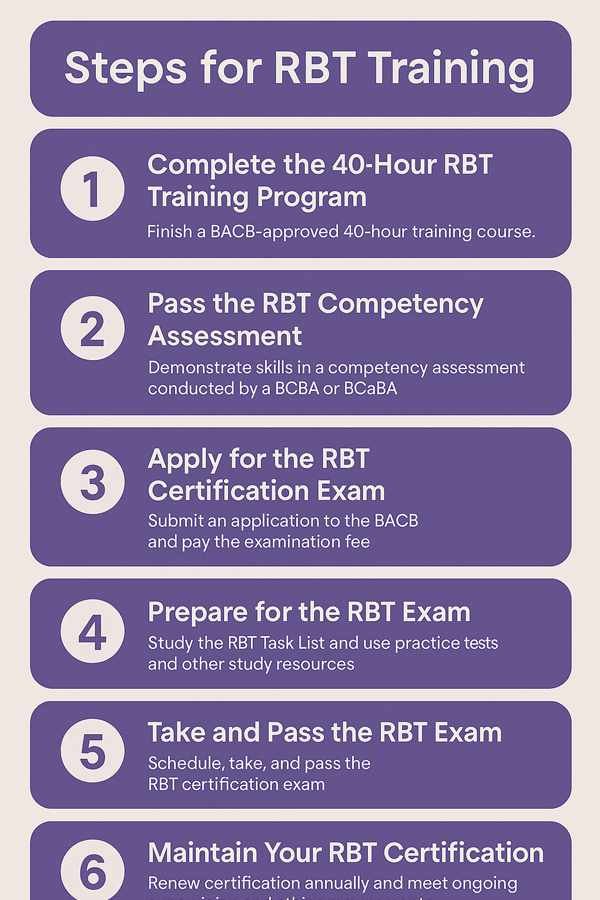What are the steps for RBT training?
If you’re looking to become a Registered Behavior Technician (RBT), understanding the steps for RBT training is crucial. This credential, issued by the Behavior Analyst Certification Board (BACB), requires completing specific coursework, hands-on training, competency assessments, and passing a certification exam. The process ensures that RBTs are well-equipped to assist Board Certified Behavior Analysts (BCBAs) in delivering applied behavior analysis (ABA) therapy effectively.
In this guide, we’ll break down the RBT training process into clear, actionable steps, including eligibility criteria, the 40-hour training program, competency assessment, exam preparation, and maintaining certification. Whether you’re entering the field of ABA or advancing your career, this roadmap will help you navigate the RBT certification requirements efficiently.
Who Can Enroll in RBT Training?
Before diving into the steps for RBT training, you must ensure you meet the eligibility criteria set by the BACB. Here’s a quick checklist:
Eligibility Requirements for RBT Certification
| Requirement | Details |
|---|---|
| Minimum Age | Must be at least 18 years old. |
| Education | High school diploma or equivalent. |
| Background Check | Must pass a criminal background check (within 180 days of applying). |
| Training Completion | Finish a 40-hour RBT training program. |
| Competency Assessment | Pass a skills assessment conducted by a BCBA or BCaBA. |
| Exam Registration | Apply for and pass the RBT certification exam. |
If you meet these prerequisites, you can proceed with the RBT training steps.
Step-by-Step Breakdown of the RBT Training Process
1. Complete the 40-Hour RBT Training Program
The first major step in RBT training is completing a BACB-approved 40-hour course. This training covers the RBT Task List, which includes:
- Measurement – Data collection methods in ABA.
- Assessment – Assisting with behavior assessments.
- Skill Acquisition – Implementing ABA teaching strategies.
- Behavior Reduction – Managing challenging behaviors.
- Documentation & Reporting – Maintaining client records.
- Professional Conduct – Ethics and compliance in ABA therapy.
🔹 Where to Take the Training?
- Online platforms (self-paced or instructor-led).
- University-sponsored programs.
- Employer-provided training (many ABA agencies offer in-house programs).
For a deeper dive into the RBT Task List, check out this detailed breakdown.
2. Pass the RBT Competency Assessment
After completing the 40-hour training, you must undergo a competency assessment conducted by a qualified BCBA or BCaBA. This evaluation ensures you can apply ABA techniques effectively.
What’s Tested in the Competency Assessment?
| Skill Area | Example Tasks |
|---|---|
| Measurement | Accurately recording frequency, duration, and latency data. |
| Behavior Reduction | Implementing interventions for maladaptive behaviors. |
| Discrete Trial Training (DTT) | Conducting structured teaching sessions. |
| Naturalistic Teaching | Using incidental teaching methods. |
| Ethical Compliance | Following BACB’s Professional and Ethical Compliance Code. |
🔹 Pro Tip: Many trainees struggle with the behavior reduction section. To prepare, review this RBT study guide on behavior reduction.
3. Apply for the RBT Certification Exam
Once you’ve passed the competency assessment, you can apply for the RBT certification exam through the BACB website. Here’s how:
- Create a BACB account (if you don’t have one).
- Submit proof of completed training and competency assessment.
- Pay the application fee ($50 as of 2024).
- Receive approval (usually within 1-2 weeks).
- Schedule your exam at a Pearson VUE testing center or online.
🔹 Exam Structure:
- 75 multiple-choice questions (85 if including unscored pilot questions).
- 90-minute time limit.
- Passing score is around 80% (though the BACB does not publish exact figures).
For more details, see the RBT exam structure guide.
4. Prepare for the RBT Exam
Passing the exam requires structured preparation. Here’s a study plan to maximize success:
Recommended RBT Exam Study Resources
| Resource | How It Helps |
|---|---|
| BACB’s RBT Task List | Official guide to what’s on the exam. |
| RBT Practice Tests | Simulates real exam questions. |
| Flashcards | Reinforces key ABA terminology. |
| Study Groups | Peer discussions clarify difficult concepts. |
🔹 Best Practice: Take a 75-question RBT practice test to assess readiness.
5. Take and Pass the RBT Exam
On exam day:
✔ Arrive early (if taking in-person).
✔ Bring valid ID.
✔ Stay calm—read each question carefully.
🔹 What If You Fail?
- You can retake the exam after a 7-day waiting period.
- The BACB allows 8 attempts within a year.
For more on retake policies, visit the BACB’s official site (external link).
6. Maintain Your RBT Certification
After passing the exam, you must:
✅ Renew annually (submit renewal application + fee).
✅ Complete ongoing supervision (at least 5% of monthly hours supervised by a BCBA).
✅ Adhere to the BACB’s ethics code.
Failure to meet these requirements results in certification lapse.

Common Challenges in RBT Training & How to Overcome Them
| Challenge | Solution |
|---|---|
| Time Management | Break the 40-hour training into 2-3 weeks. |
| Exam Anxiety | Use timed practice tests to build confidence. |
| Competency Assessment Nerves | Role-play scenarios with a supervisor beforehand. |
Final Thoughts
Becoming an RBT is a structured yet achievable process. By following these steps for RBT training, you’ll be well-prepared for certification and a rewarding career in ABA therapy.
For further reading, explore our RBT study guide collection.
This guide ensures you have a clear, actionable roadmap to RBT certification. Good luck on your journey! 🚀






